Designing Cantilever and Retaining Wall Structures Assignment
VerifiedAdded on 2023/06/11
|11
|1228
|107
Report
AI Summary
This assignment provides a detailed solution for the design of cantilever and retaining walls. It includes foundation design, wall proportioning, stem design with shear checking and analysis, and stability checks. The design adheres to relevant standards, incorporating calculations for overturning, sliding, and subsidence. The pressure analysis confirms the safety of the slab beneath the cantilever. The assignment also covers slab heel design, ensuring structural integrity. References to relevant publications are included. Desklib is a platform where students can find similar solved assignments and past papers.
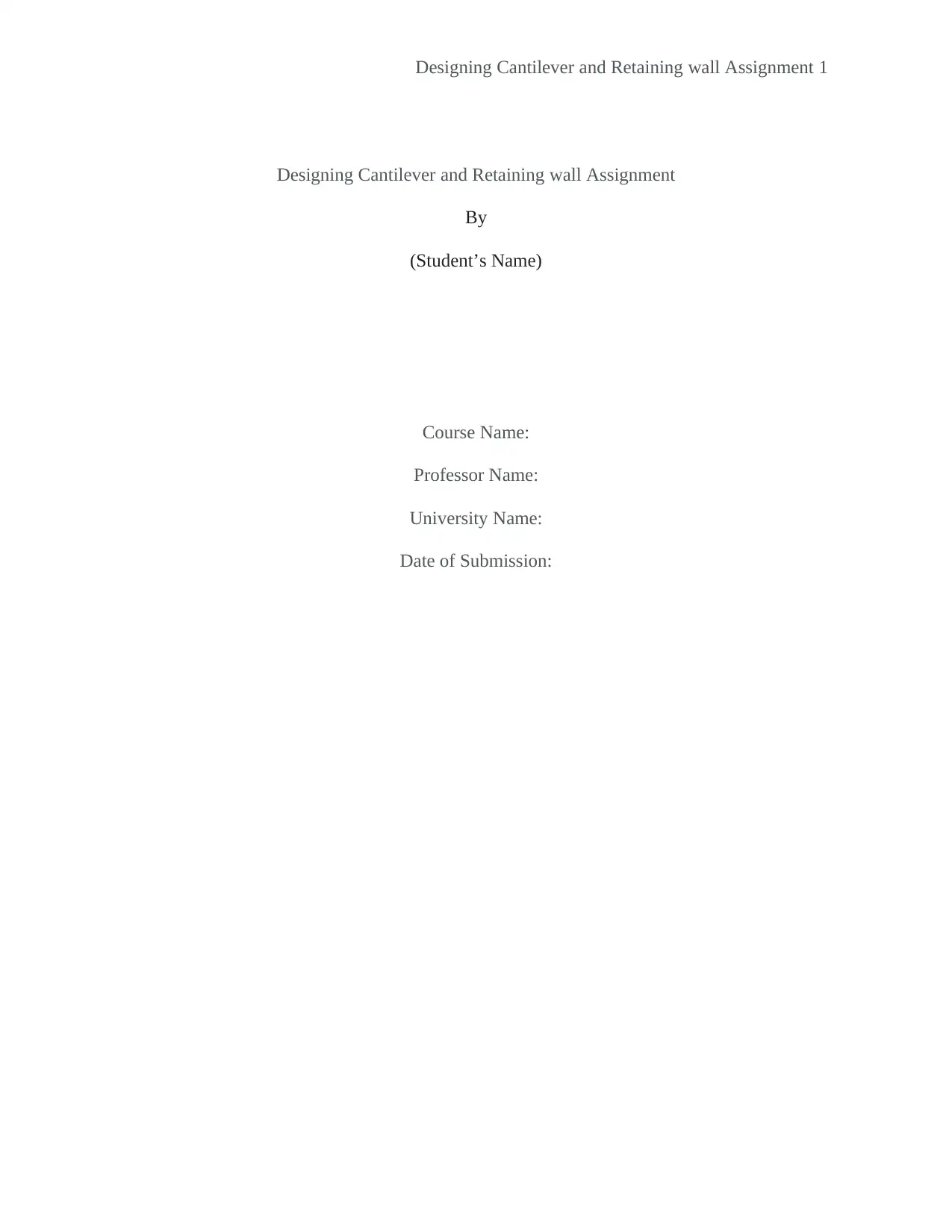
Designing Cantilever and Retaining wall Assignment 1
Designing Cantilever and Retaining wall Assignment
By
(Student’s Name)
Course Name:
Professor Name:
University Name:
Date of Submission:
Designing Cantilever and Retaining wall Assignment
By
(Student’s Name)
Course Name:
Professor Name:
University Name:
Date of Submission:
Paraphrase This Document
Need a fresh take? Get an instant paraphrase of this document with our AI Paraphraser
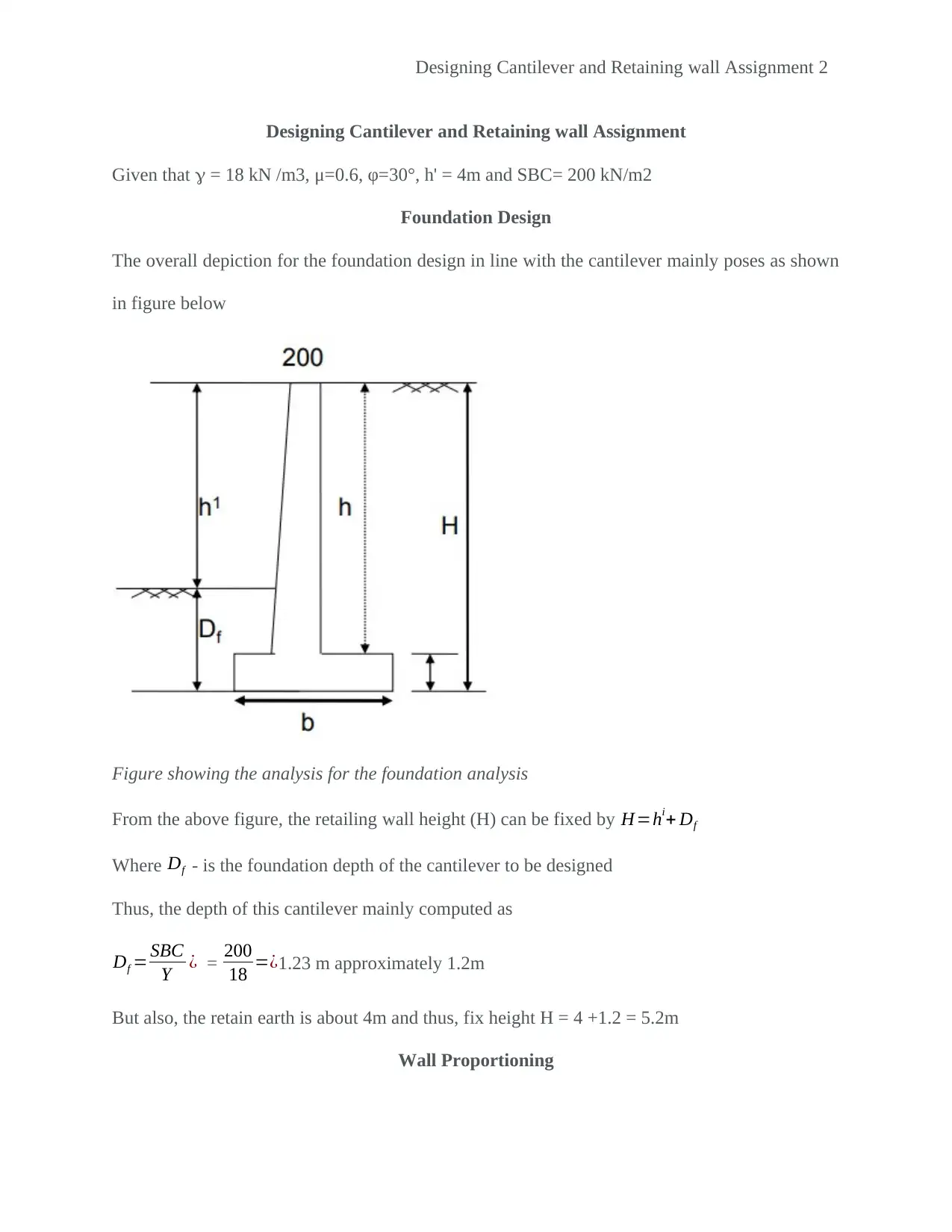
Designing Cantilever and Retaining wall Assignment 2
Designing Cantilever and Retaining wall Assignment
Given that = 18 kN /m3, μ=0.6, φ=30°, h' = 4m and SBC= 200 kN/m2
Foundation Design
The overall depiction for the foundation design in line with the cantilever mainly poses as shown
in figure below
Figure showing the analysis for the foundation analysis
From the above figure, the retailing wall height (H) can be fixed by H=hi+ Df
Where Df - is the foundation depth of the cantilever to be designed
Thus, the depth of this cantilever mainly computed as
Df = SBC
Y ¿ = 200
18 =¿1.23 m approximately 1.2m
But also, the retain earth is about 4m and thus, fix height H = 4 +1.2 = 5.2m
Wall Proportioning
Designing Cantilever and Retaining wall Assignment
Given that = 18 kN /m3, μ=0.6, φ=30°, h' = 4m and SBC= 200 kN/m2
Foundation Design
The overall depiction for the foundation design in line with the cantilever mainly poses as shown
in figure below
Figure showing the analysis for the foundation analysis
From the above figure, the retailing wall height (H) can be fixed by H=hi+ Df
Where Df - is the foundation depth of the cantilever to be designed
Thus, the depth of this cantilever mainly computed as
Df = SBC
Y ¿ = 200
18 =¿1.23 m approximately 1.2m
But also, the retain earth is about 4m and thus, fix height H = 4 +1.2 = 5.2m
Wall Proportioning
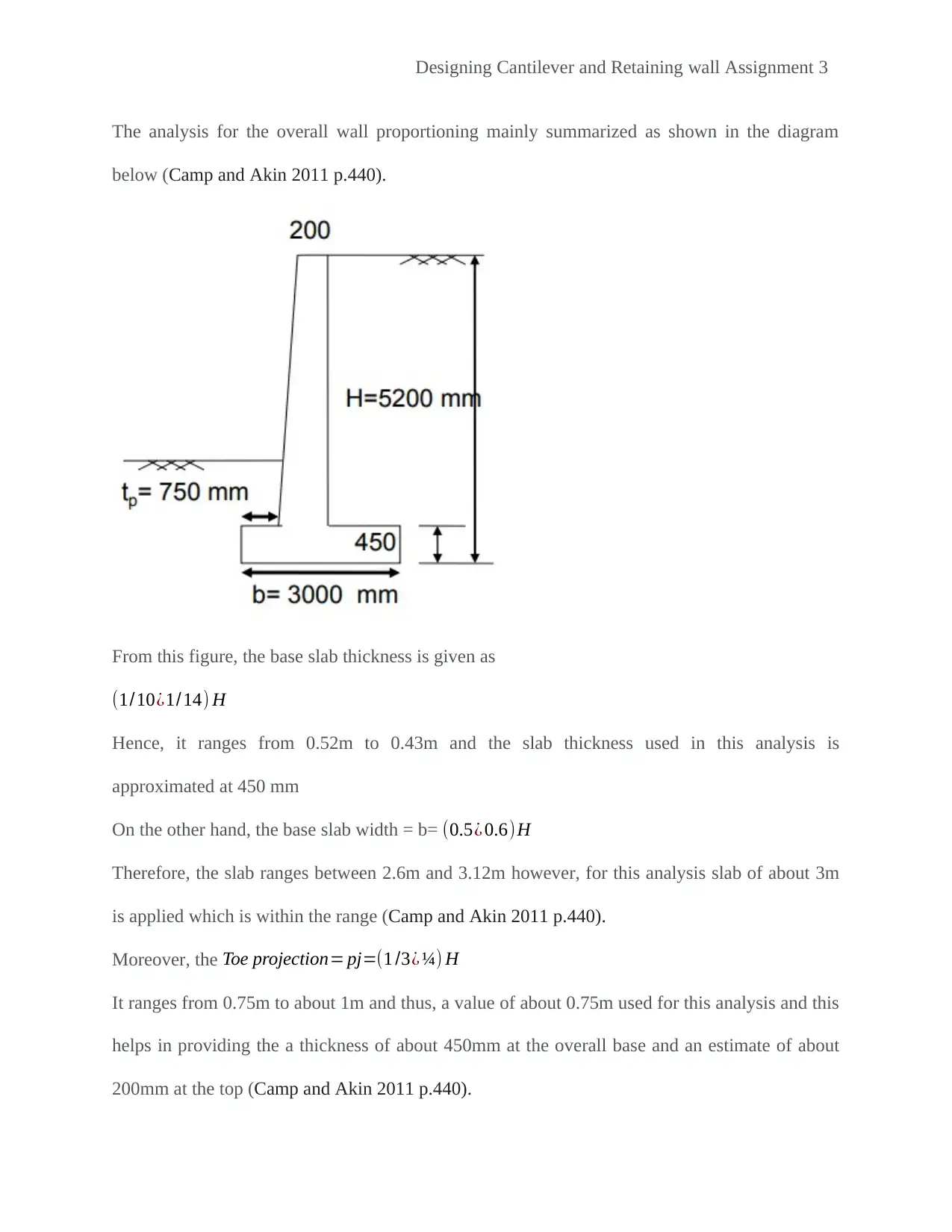
Designing Cantilever and Retaining wall Assignment 3
The analysis for the overall wall proportioning mainly summarized as shown in the diagram
below (Camp and Akin 2011 p.440).
From this figure, the base slab thickness is given as
(1/10¿1/ 14) H
Hence, it ranges from 0.52m to 0.43m and the slab thickness used in this analysis is
approximated at 450 mm
On the other hand, the base slab width = b= (0.5¿ 0.6)H
Therefore, the slab ranges between 2.6m and 3.12m however, for this analysis slab of about 3m
is applied which is within the range (Camp and Akin 2011 p.440).
Moreover, the Toe projection= pj=(1 /3¿ ¼) H
It ranges from 0.75m to about 1m and thus, a value of about 0.75m used for this analysis and this
helps in providing the a thickness of about 450mm at the overall base and an estimate of about
200mm at the top (Camp and Akin 2011 p.440).
The analysis for the overall wall proportioning mainly summarized as shown in the diagram
below (Camp and Akin 2011 p.440).
From this figure, the base slab thickness is given as
(1/10¿1/ 14) H
Hence, it ranges from 0.52m to 0.43m and the slab thickness used in this analysis is
approximated at 450 mm
On the other hand, the base slab width = b= (0.5¿ 0.6)H
Therefore, the slab ranges between 2.6m and 3.12m however, for this analysis slab of about 3m
is applied which is within the range (Camp and Akin 2011 p.440).
Moreover, the Toe projection= pj=(1 /3¿ ¼) H
It ranges from 0.75m to about 1m and thus, a value of about 0.75m used for this analysis and this
helps in providing the a thickness of about 450mm at the overall base and an estimate of about
200mm at the top (Camp and Akin 2011 p.440).
⊘ This is a preview!⊘
Do you want full access?
Subscribe today to unlock all pages.

Trusted by 1+ million students worldwide
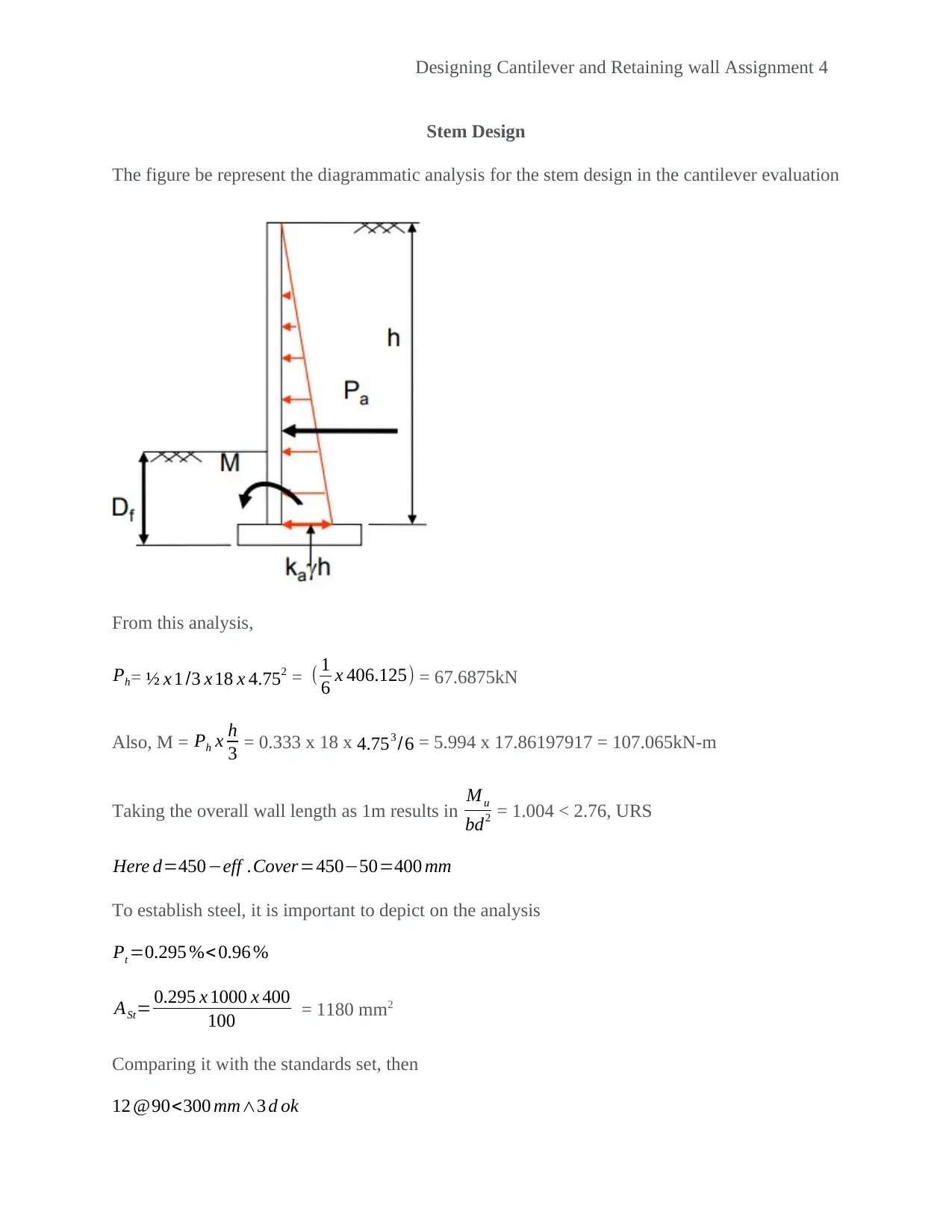
Designing Cantilever and Retaining wall Assignment 4
Stem Design
The figure be represent the diagrammatic analysis for the stem design in the cantilever evaluation
From this analysis,
Ph= ½ x 1 /3 x 18 x 4.752 = ( 1
6 x 406.125) = 67.6875kN
Also, M = Ph x h
3 = 0.333 x 18 x 4.753 /6 = 5.994 x 17.86197917 = 107.065kN-m
Taking the overall wall length as 1m results in M u
bd2 = 1.004 < 2.76, URS
Here d=450−eff .Cover=450−50=400 mm
To establish steel, it is important to depict on the analysis
Pt =0.295 %< 0.96 %
ASt= 0.295 x 1000 x 400
100 = 1180 mm2
Comparing it with the standards set, then
12 @90<300 mm∧3 d ok
Stem Design
The figure be represent the diagrammatic analysis for the stem design in the cantilever evaluation
From this analysis,
Ph= ½ x 1 /3 x 18 x 4.752 = ( 1
6 x 406.125) = 67.6875kN
Also, M = Ph x h
3 = 0.333 x 18 x 4.753 /6 = 5.994 x 17.86197917 = 107.065kN-m
Taking the overall wall length as 1m results in M u
bd2 = 1.004 < 2.76, URS
Here d=450−eff .Cover=450−50=400 mm
To establish steel, it is important to depict on the analysis
Pt =0.295 %< 0.96 %
ASt= 0.295 x 1000 x 400
100 = 1180 mm2
Comparing it with the standards set, then
12 @90<300 mm∧3 d ok
Paraphrase This Document
Need a fresh take? Get an instant paraphrase of this document with our AI Paraphraser
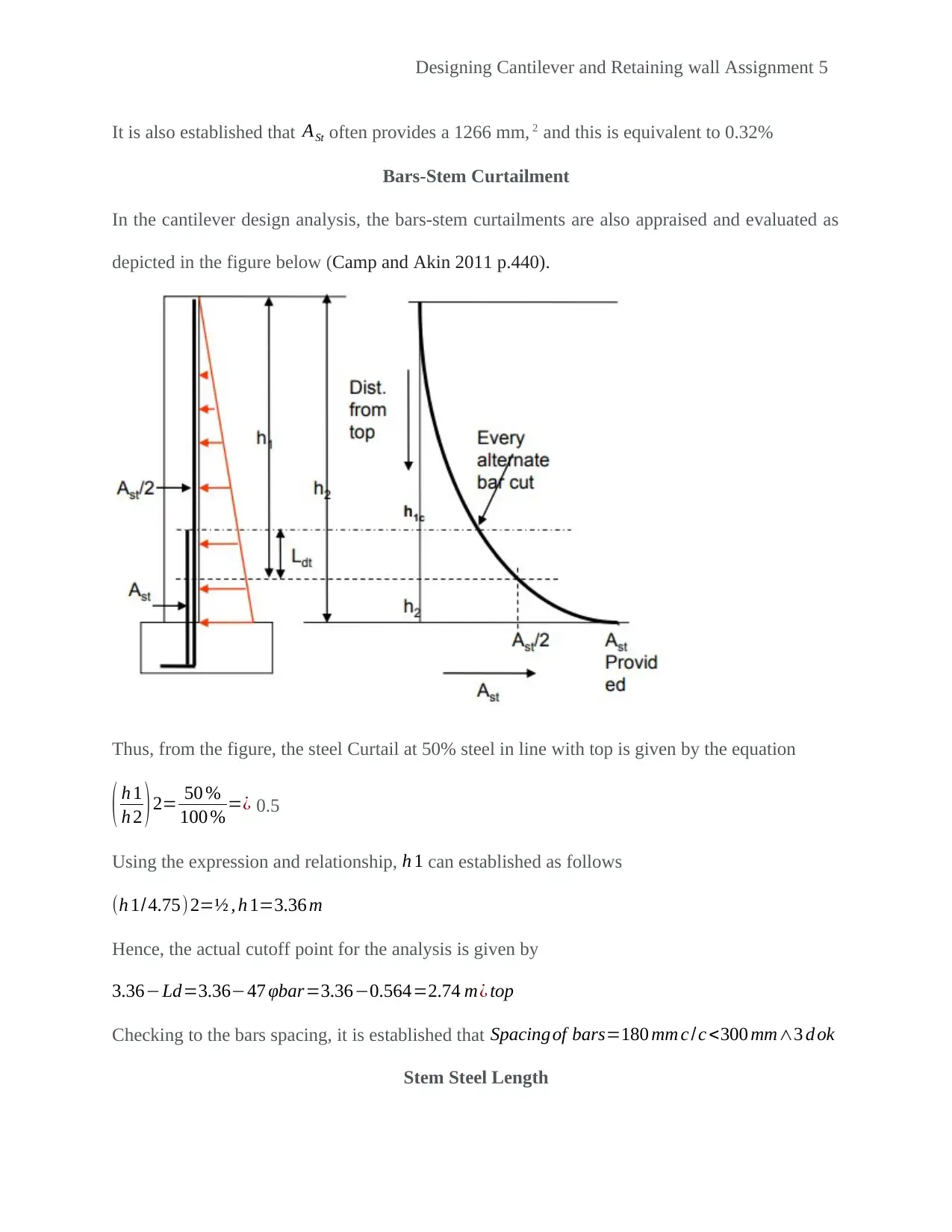
Designing Cantilever and Retaining wall Assignment 5
It is also established that ASt often provides a 1266 mm, 2 and this is equivalent to 0.32%
Bars-Stem Curtailment
In the cantilever design analysis, the bars-stem curtailments are also appraised and evaluated as
depicted in the figure below (Camp and Akin 2011 p.440).
Thus, from the figure, the steel Curtail at 50% steel in line with top is given by the equation
( h 1
h 2 ) 2= 50 %
100 %=¿ 0.5
Using the expression and relationship, h 1 can established as follows
(h 1/4.75)2=½ , h 1=3.36 m
Hence, the actual cutoff point for the analysis is given by
3.36−Ld=3.36−47 φbar=3.36−0.564=2.74 m¿ top
Checking to the bars spacing, it is established that Spacingof bars=180 mm c /c <300 mm∧3 d ok
Stem Steel Length
It is also established that ASt often provides a 1266 mm, 2 and this is equivalent to 0.32%
Bars-Stem Curtailment
In the cantilever design analysis, the bars-stem curtailments are also appraised and evaluated as
depicted in the figure below (Camp and Akin 2011 p.440).
Thus, from the figure, the steel Curtail at 50% steel in line with top is given by the equation
( h 1
h 2 ) 2= 50 %
100 %=¿ 0.5
Using the expression and relationship, h 1 can established as follows
(h 1/4.75)2=½ , h 1=3.36 m
Hence, the actual cutoff point for the analysis is given by
3.36−Ld=3.36−47 φbar=3.36−0.564=2.74 m¿ top
Checking to the bars spacing, it is established that Spacingof bars=180 mm c /c <300 mm∧3 d ok
Stem Steel Length
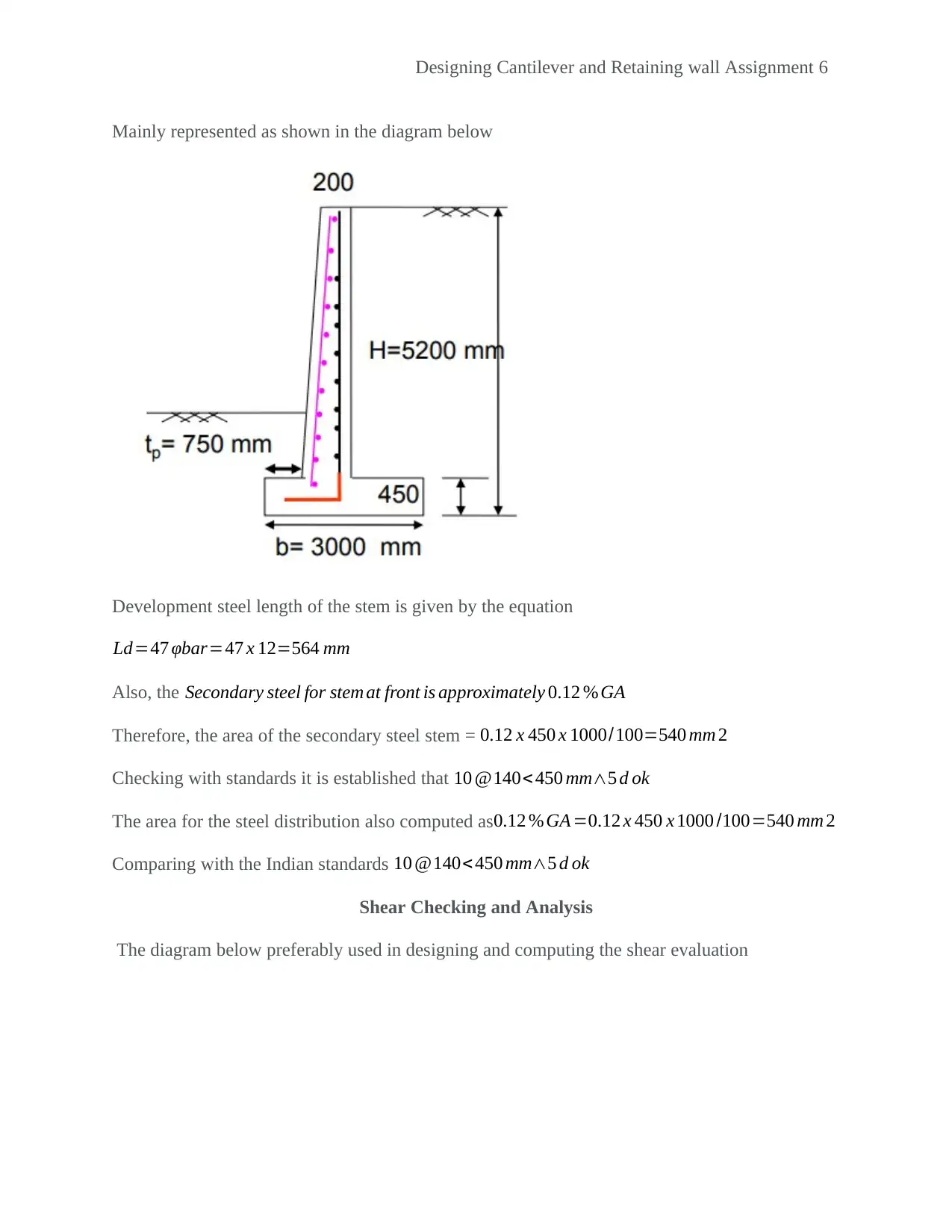
Designing Cantilever and Retaining wall Assignment 6
Mainly represented as shown in the diagram below
Development steel length of the stem is given by the equation
Ld=47 φbar=47 x 12=564 mm
Also, the Secondary steel for stem at front is approximately 0.12 % GA
Therefore, the area of the secondary steel stem = 0.12 x 450 x 1000/100=540 mm 2
Checking with standards it is established that 10 @140< 450 mm∧5 d ok
The area for the steel distribution also computed as0.12 % GA =0.12 x 450 x 1000 /100=540 mm 2
Comparing with the Indian standards 10 @140<450 mm∧5 d ok
Shear Checking and Analysis
The diagram below preferably used in designing and computing the shear evaluation
Mainly represented as shown in the diagram below
Development steel length of the stem is given by the equation
Ld=47 φbar=47 x 12=564 mm
Also, the Secondary steel for stem at front is approximately 0.12 % GA
Therefore, the area of the secondary steel stem = 0.12 x 450 x 1000/100=540 mm 2
Checking with standards it is established that 10 @140< 450 mm∧5 d ok
The area for the steel distribution also computed as0.12 % GA =0.12 x 450 x 1000 /100=540 mm 2
Comparing with the Indian standards 10 @140<450 mm∧5 d ok
Shear Checking and Analysis
The diagram below preferably used in designing and computing the shear evaluation
⊘ This is a preview!⊘
Do you want full access?
Subscribe today to unlock all pages.

Trusted by 1+ million students worldwide
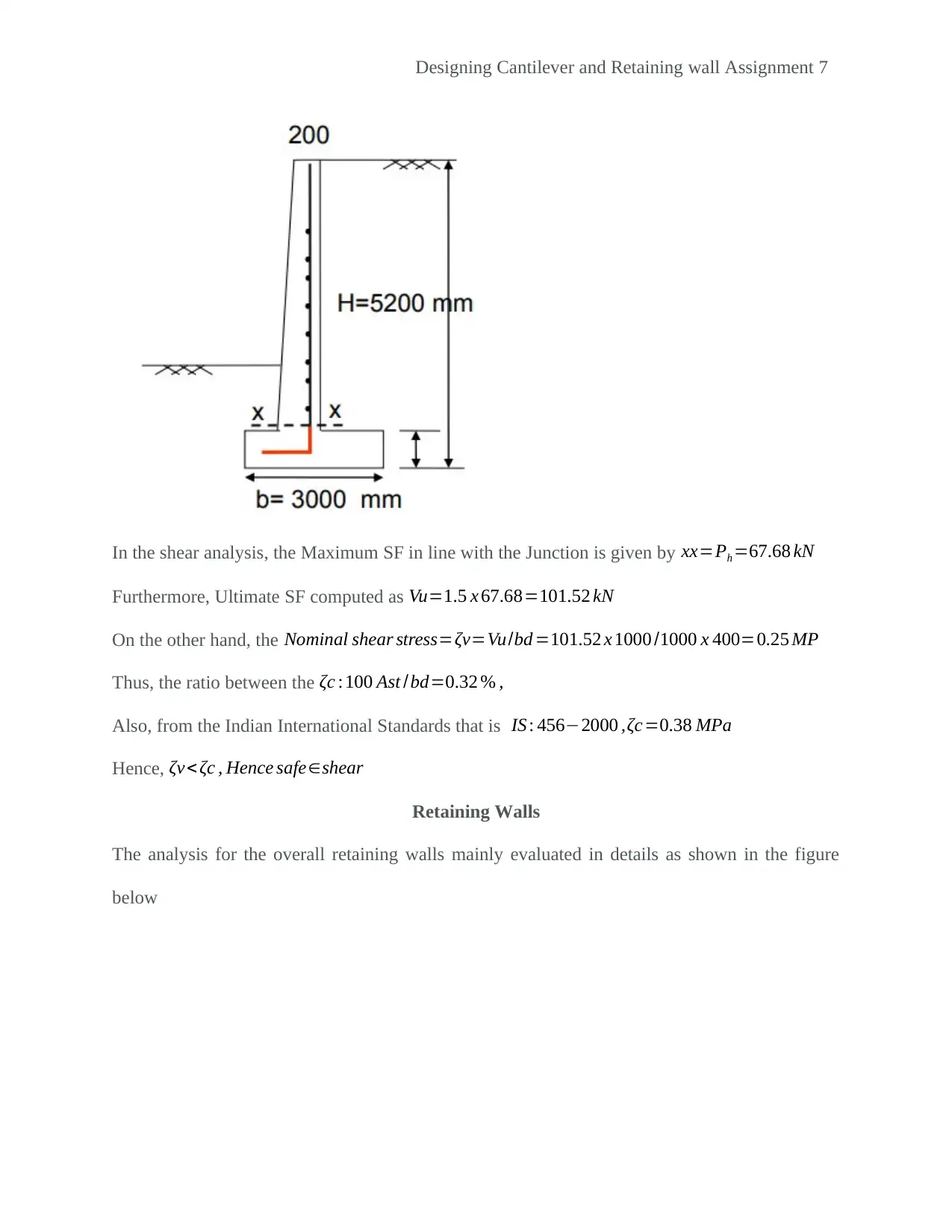
Designing Cantilever and Retaining wall Assignment 7
In the shear analysis, the Maximum SF in line with the Junction is given by xx=Ph =67.68 kN
Furthermore, Ultimate SF computed as Vu=1.5 x 67.68=101.52 kN
On the other hand, the Nominal shear stress=ζv=Vu/bd =101.52 x 1000 /1000 x 400=0.25 MP
Thus, the ratio between the ζc :100 Ast /bd=0.32 % ,
Also, from the Indian International Standards that is IS : 456−2000 ,ζc=0.38 MPa
Hence, ζv< ζc , Hence safe∈shear
Retaining Walls
The analysis for the overall retaining walls mainly evaluated in details as shown in the figure
below
In the shear analysis, the Maximum SF in line with the Junction is given by xx=Ph =67.68 kN
Furthermore, Ultimate SF computed as Vu=1.5 x 67.68=101.52 kN
On the other hand, the Nominal shear stress=ζv=Vu/bd =101.52 x 1000 /1000 x 400=0.25 MP
Thus, the ratio between the ζc :100 Ast /bd=0.32 % ,
Also, from the Indian International Standards that is IS : 456−2000 ,ζc=0.38 MPa
Hence, ζv< ζc , Hence safe∈shear
Retaining Walls
The analysis for the overall retaining walls mainly evaluated in details as shown in the figure
below
Paraphrase This Document
Need a fresh take? Get an instant paraphrase of this document with our AI Paraphraser
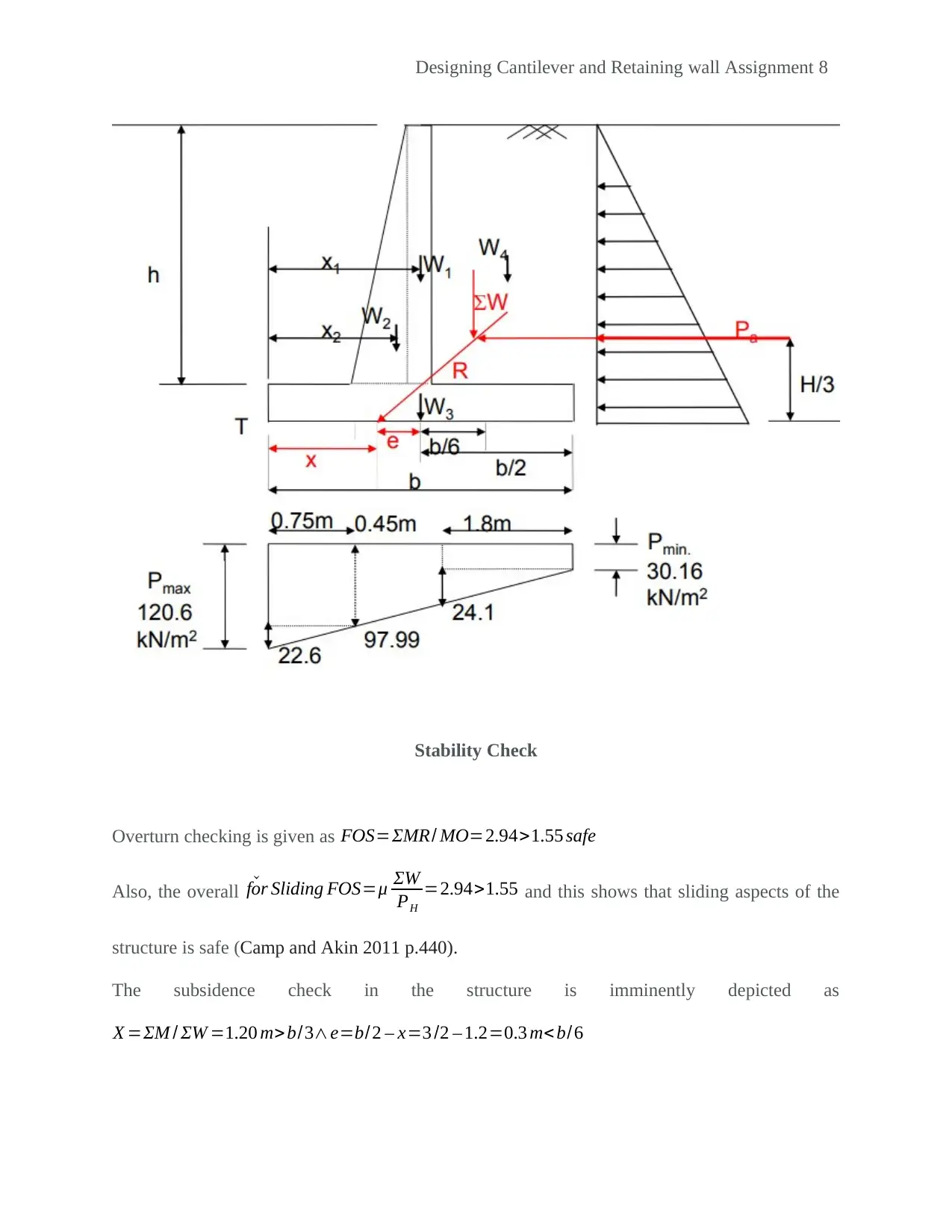
Designing Cantilever and Retaining wall Assignment 8
Stability Check
Overturn checking is given as FOS=ΣMR/ MO=2.94>1.55 safe
Also, the overall ˇfor Sliding FOS=μ ΣW
PH
=2.94>1.55 and this shows that sliding aspects of the
structure is safe (Camp and Akin 2011 p.440).
The subsidence check in the structure is imminently depicted as
X =ΣM / ΣW =1.20 m> b/3∧e=b/2 – x=3 /2 – 1.2=0.3 m< b/6
Stability Check
Overturn checking is given as FOS=ΣMR/ MO=2.94>1.55 safe
Also, the overall ˇfor Sliding FOS=μ ΣW
PH
=2.94>1.55 and this shows that sliding aspects of the
structure is safe (Camp and Akin 2011 p.440).
The subsidence check in the structure is imminently depicted as
X =ΣM / ΣW =1.20 m> b/3∧e=b/2 – x=3 /2 – 1.2=0.3 m< b/6
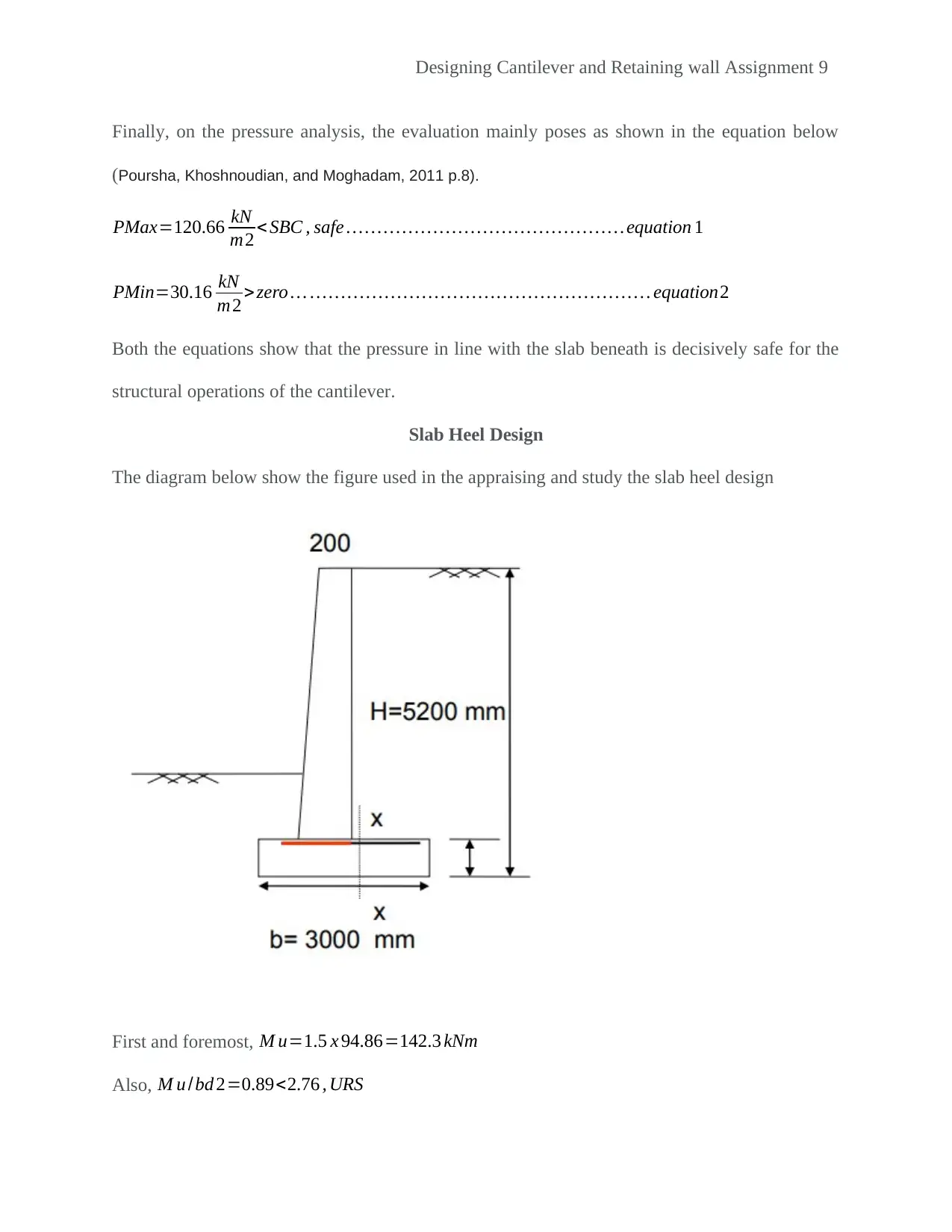
Designing Cantilever and Retaining wall Assignment 9
Finally, on the pressure analysis, the evaluation mainly poses as shown in the equation below
(Poursha, Khoshnoudian, and Moghadam, 2011 p.8).
PMax=120.66 kN
m2 < SBC , safe … … … … … … … … … … … … … … … equation 1
PMin=30.16 kN
m2 >zero … … … … … … … … … … …… … … … … … … … . equation2
Both the equations show that the pressure in line with the slab beneath is decisively safe for the
structural operations of the cantilever.
Slab Heel Design
The diagram below show the figure used in the appraising and study the slab heel design
First and foremost, M u=1.5 x 94.86=142.3 kNm
Also, M u /bd 2=0.89<2.76 , URS
Finally, on the pressure analysis, the evaluation mainly poses as shown in the equation below
(Poursha, Khoshnoudian, and Moghadam, 2011 p.8).
PMax=120.66 kN
m2 < SBC , safe … … … … … … … … … … … … … … … equation 1
PMin=30.16 kN
m2 >zero … … … … … … … … … … …… … … … … … … … . equation2
Both the equations show that the pressure in line with the slab beneath is decisively safe for the
structural operations of the cantilever.
Slab Heel Design
The diagram below show the figure used in the appraising and study the slab heel design
First and foremost, M u=1.5 x 94.86=142.3 kNm
Also, M u /bd 2=0.89<2.76 , URS
⊘ This is a preview!⊘
Do you want full access?
Subscribe today to unlock all pages.

Trusted by 1+ million students worldwide

Designing Cantilever and Retaining wall Assignment 10
Pt =0.264 %<0.96 % In line with the international standards
However, area is given by Ast =0.264 x 1000 x 400/100 = =1056 mm2
Hence, 16 @190<300 mm∧3 d ok Ast provided=1058 mm [0.27 %]
Pt =0.264 %<0.96 % In line with the international standards
However, area is given by Ast =0.264 x 1000 x 400/100 = =1056 mm2
Hence, 16 @190<300 mm∧3 d ok Ast provided=1058 mm [0.27 %]
Paraphrase This Document
Need a fresh take? Get an instant paraphrase of this document with our AI Paraphraser
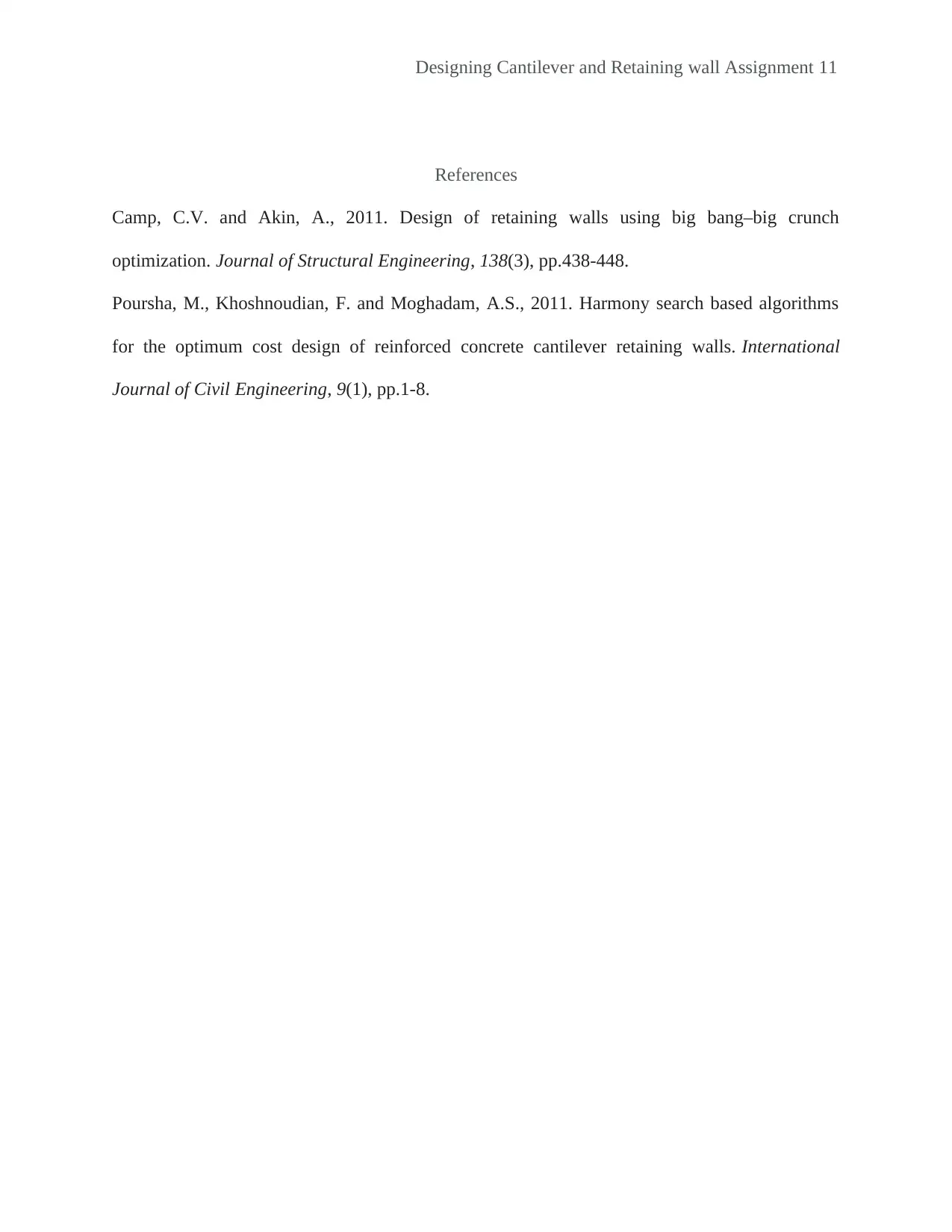
Designing Cantilever and Retaining wall Assignment 11
References
Camp, C.V. and Akin, A., 2011. Design of retaining walls using big bang–big crunch
optimization. Journal of Structural Engineering, 138(3), pp.438-448.
Poursha, M., Khoshnoudian, F. and Moghadam, A.S., 2011. Harmony search based algorithms
for the optimum cost design of reinforced concrete cantilever retaining walls. International
Journal of Civil Engineering, 9(1), pp.1-8.
References
Camp, C.V. and Akin, A., 2011. Design of retaining walls using big bang–big crunch
optimization. Journal of Structural Engineering, 138(3), pp.438-448.
Poursha, M., Khoshnoudian, F. and Moghadam, A.S., 2011. Harmony search based algorithms
for the optimum cost design of reinforced concrete cantilever retaining walls. International
Journal of Civil Engineering, 9(1), pp.1-8.
1 out of 11
Your All-in-One AI-Powered Toolkit for Academic Success.
+13062052269
info@desklib.com
Available 24*7 on WhatsApp / Email
![[object Object]](/_next/static/media/star-bottom.7253800d.svg)
Unlock your academic potential
Copyright © 2020–2025 A2Z Services. All Rights Reserved. Developed and managed by ZUCOL.